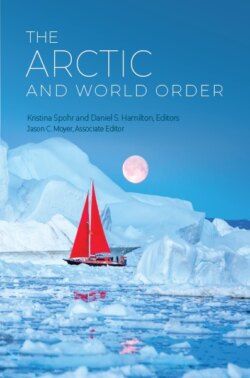Читать книгу The Arctic and World Order - Группа авторов - Страница 23
На сайте Литреса книга снята с продажи.
The Arctic Today
ОглавлениеWith well-established institutions and a long record of international good will, is the Arctic well prepared for environmental and societal change? In some ways, we as a society can be optimistic.9 The nearest the Arctic comes to a land rush is the quest for rights to extended continental shelves. Russia planted a symbolic flag on the seafloor at the North Pole, but the claims will be staked and evaluated not on the high seas but in the procedures laid out in the United Nations Convention on the Law of the Sea. 10 The IMO has created the Polar Code, which came into force on January 1, 2017, to be ready for expected increases in commercial vessel traffic.11 Nine countries and the European Union signed the Agreement to Prevent Unregulated High Seas Fisheries in the Central Arctic Ocean in October 2018,12 and at the time of writing this precautionary approach to fisheries management awaits only one ratification to come into force. The Iñupiat of northern Alaska and the Inuvialuit of northwestern Canada have created trans-boundary cooperative agreements to manage polar bears and others species.13 A recent major resource development effort, the Yamal Liquid Natural Gas project in northern Russia, is a joint venture of companies from Russia, China, and France, all following norms of international business partnerships.14
And yet as a society we can also be pessimistic. Arctic resources, from fish to oil and from shipping routes to tourist attractions, attract global attention. With attention comes interest in and pressure to develop.15 The Arctic is not immune to industrial accidents, and pollution and disturbance can harm the Arctic environment, as they can anywhere. Strong conservation measures in one place can easily be undermined by unconstrained exploitation elsewhere, since neither fish nor spilled oil stop at a border or edge of a protected area. The global problem of persistent organic pollution became ever more apparent in the 1980s and 1990s when high levels of heavy metals and persistent organic pollutants were found in Arctic species and in Arctic residents, far from the places where the contaminants were produced and used.16 Today, the global problem of plastic waste reaches into the Arctic as well,17 fouling beaches and being ingested by fish, birds, and mammals.
Despite the abundance of institutions and cooperation, the Arctic remains susceptible to creeping degradation as countless small decisions and actions nibble away at environmental and cultural integrity. Each of these changes may be relatively minor in itself, and many are even welcomed as a form of progress, providing jobs and opportunities where few existed. Indeed, this is nothing new. For centuries, people from lower latitudes have gone north in search of furs, whales, walrus ivory, gold, oil, and more. Local people have often joined in the trade for such products.18 And as a result, bowhead whale populations were decimated in the late 1800s and early 1900s,19 pollock all but disappeared from the central Bering Sea in the 1980s,20 and Russia’s Komi Republic suffered a massive oil spill from a broken pipeline in 1994–95. In Krasnoyarsk Krai region, the May 2020 Norilsk diesel oil spill flooded rivers and is an ongoing devastating industrial disaster, even if on a smaller scale than the 1990s disaster in Komi.21 Schooling provides formal education, but often at the expense of passing on traditional knowledge through long practice and interactions on the land and sea. Employment provides income, but often at a cost of the time needed for hunting, fishing, and gathering. National languages are convenient, but Indigenous languages and cultural heritage are being lost.22
We are thus caught in a dilemma. The Arctic of old was beset by poverty, low life expectancy, and other unwelcome features of the pre-modern world. Modernization has hardly been painless, but it has brought many benefits, including longer life expectancy and reduced poverty, though in most countries Arctic averages remain worse than national averages.23 Development of Arctic resources is one way to pay for these benefits, if Arctic regions are to stand on more than the largesse of national governments centered to the south. But development brings its own problems, which increase as industrial activities spread wider on the lands and the waters, leaving less and less undisturbed space for Arctic species and Arctic peoples. This pattern has been seen around the world, as ancient homelands become “new frontiers,” which then become settled areas with only a few relics of the past tucked into parks, displayed in museums, or left as place names on a map.
